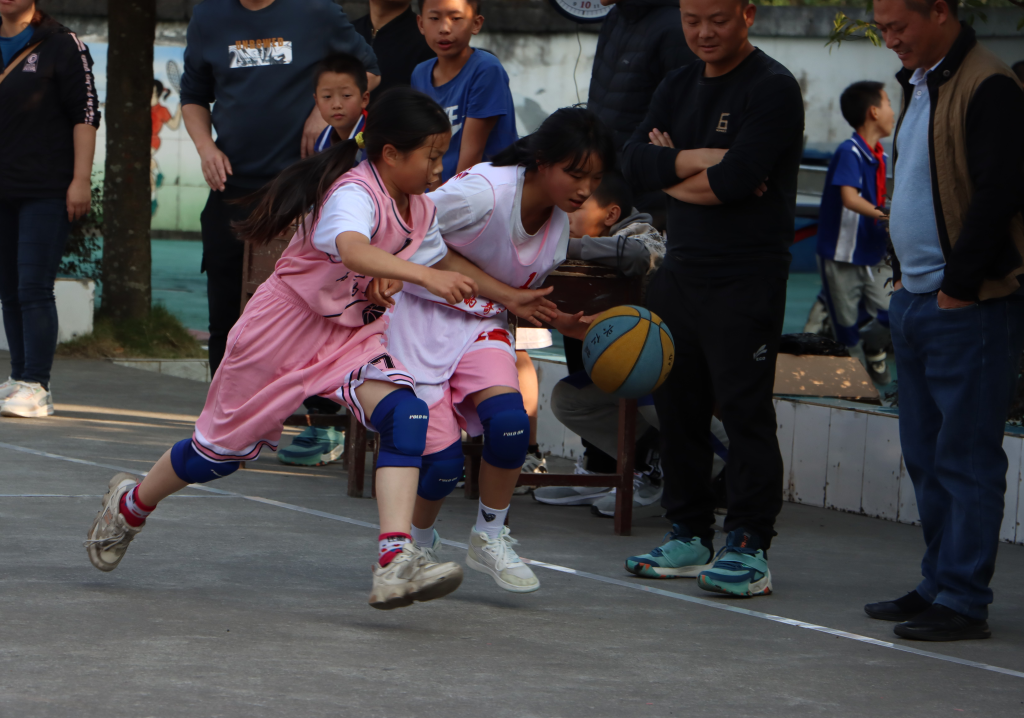
Students from Tangfang Primary School compete in a basketball game on Nov. 9, 2022. (Xinhua/Zheng Minghong)
In addition to enriching rural school students' lives, sports have also bolstered their confidence, demeanor and cheerfulness in southwestern Guizhou Province.
GUIYANG, China, Aug. 16 (Xinhua) -- In a basketball league catering to students under the age of 12 in southwest China's Guizhou Province, a women's team from the Qianxinan Bouyei and Miao Autonomous Prefecture played its final group game on Monday and failed to advance.
The team consists of 12 players, eight of whom are from Tangfang Primary School, a remote rural school with 527 students, located in Baling Town, Xingren City of the Qianxinan Bouyei and Miao Autonomous Prefecture.
Feng Shichuan, vice principal of the school, stated that "all the teams here are very strong. It's not surprising that we didn't perform well. Taking this opportunity to expose the children to the outside world and enrich their experiences is more important than the game itself."
Since 2020, the rural primary school has clinched six championships in sports competitions held by Xingren City and Qianxinan Bouyei and Miao Autonomous Prefecture. The school's conference room showcases numerous medals earned from various sports competitions.
Wu Xiong, the school's principal, shared, "Our school's sports facilities are adapted to local conditions. Though some are not standardized, they are popular among students. Our students engage in physical activity for over 2.5 hours daily."
However, in 2004 when the school was founded, the situation was different. Poor academic foundations led many students to be hesitant about attending school. This concern troubled Wu Xiong, who at the time, was a 19-year-old appointed as the school's principal in February 2004.
Searching for a solution to attract students, Wu convened his colleagues and arrived at an unconventional approach - sports. "Rural children often assist their parents with farm work, which grants them robust physical fitness and aptitude for sports," Wu explained.
Wu and his colleagues soon encountered another challenge. The school had recently shifted to a new location, lacking a flat area exceeding 20 square meters for campus play.
To overcome this hurdle, Wu and his colleagues devoted their spare time to a nearby construction site. They collected sand and stones as rewards to fill potholes on the campus. This task took nearly two years to complete.
In November 2006, the school conducted its inaugural sports meet on the leveled ground. Feng noted that for inclusive participation, they organized at least two team events per session, such as tug-of-war, based on class divisions.
Wu recalled, "We surveyed students to gauge their preferred games, then structured sports events accordingly. This approach ignited enthusiasm for participating in the sports meet."
Starting in September 2021, the school reformed interclass activities. Instead of standardized exercise, they introduced dance, hula-hoop, and other projects.
Moreover, the school initiated monthly sports competitions since then, encompassing basketball, table tennis, chess, etc., aiming to further enrich students' campus lives. During each competition, Wu and his colleagues livestreamed on platforms like TikTok, showcasing students' campus experiences to their parents, typically employed in coastal factories across China.
Balancing these concerns, Wu noted that certain teachers were skeptical about "promoting school through sports," fearing it might hinder academic performance. To maintain an equilibrium between sports and academics, students must complete their scholastic tasks first.
Thanks to support from local authorities and enterprises, the school's sports facilities witnessed substantial enhancement. In April, a new track was completed, and in July, the Cai Chongxin Foundation donated 300,000 yuan (about 41,170 U.S. dollars) to bolster sports facilities and facilitate student participation in higher-level competitions.
According to Wu, frequent engagement in sports activities has bolstered students' confidence, demeanor and cheerfulness, contributing to improved academic performance. Over the past 20 years, the school's average student score surged from under 30 points in 2004 to more than 80 points today. Since 2014, over 100 school graduates have enrolled as sports-focused students in various middle schools across different regions.